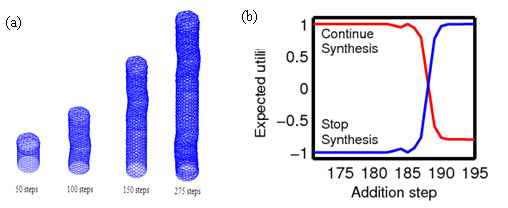
Carbon nanotubes (CNTs) are one of the promising nanostructure materials considered for industrial applications. While efforts have been made to address the optimization of the CVD and other processes used for CNT synthesis, the current production and yield rates need to be enhanced significantly to permit a much wider industrial applications. Precise control of CNT geometric features, such as length, during atomistic-scale growth processes is considered essential towards improving the quality and yield rates, and hence the large-scale industrial production. However, precise control of CNT length during the synthesis process remains a major industrial challenge.
The time-scales over which these atomistic-scale growth processes (e.g., the chemisorption mechanisms) take place are much shorter (~ 10-12 sec) than those pertinent for conventional manufacturing processes. Therefore real-time process monitoring based on models that can track the nanostructure growth evolution is deemed essential for effective quality assurance. Various experimental studies, atomistic Molecular Dynamics (MD)/Monte Carlo (MC), and continuum simulations have been attempted to discern the pertinent growth mechanisms. Due to high costs associated with experimentation, the effects of chief process conditions influencing a nanostructure (here, CNT) growth cannot be effectively delineated. Short time-scale phenomena that drive CNT growth cannot be gathered due to sensing limitations (e.g., time resolution 1-103 ms) and confounding effects present during experiments. Atomistic MD/MC simulations have therefore been attempted to gather information on the growth process that cannot be gleaned from experiments.
The current atomistic simulations are hampered by computational overhead, and are mostly limited to simulating the early stages of nanostructure growth. Continuum approximations investigated as an alternative to MD/MC models capture the variations in material concentration, but ignore the com¬plex potential functions associated with a CNT structure. Consequently, they do not track the growth tra¬jectory and the resulting geometric structures, especially over short space and time scales. Hence, a pressing need exists to speedup atomistic simulation models and augment them with experimental data to provide timely, accurate input for online monitoring.
To this end, Bukkapatnam and co-authors investigated a complex system prediction approach [2, 3] to accelerate MC simulation of the synthesis of vertically-aligned CNTs from a plasma-enhanced (PE)-CVD process. Their experimental studies suggest that the CNTs from this process were aligned vertically with fairly homogenous height distribution (see Figure 1). Consequently, the control of CNT lengths reduces to the monitoring of temporal growth of a single CNT under different synthesis conditions [3].
![Figure 1 Vertically-aligned CNTs of fairly uniform lengths grown from a substrate in a CVD process, (b) conformance of CNT growth to a specified patterned block [3]. Figure 1 Vertically-aligned CNTs of fairly uniform lengths grown from a substrate in a CVD process, (b) conformance of CNT growth to a specified patterned block [3].](/sites/internano.org/files/images/20130327_hi782_vertcnt.jpg)
In addition to advanced predictions, their approach also employs spatial coarse-graining as summarized in Figure 2 to further reduce the computational efforts for regular MC simulation. The majority (80-95%) of the computational overhead during an MC simulation is attributed to the relaxation process implemented at every growth step. If the final (near-equilibrium) state of the relaxation process, can be predicted in advance, and the relaxation process initialized therefrom, the number of MC moves and hence the computation time can be greatly reduced. Their investigations also suggested that CNT growth process exhibits nonlinear and recurring near-stationary dynamics, and a nonparametric local Gaussian process (LGP) prediction model can be effective for forecasting the final state ahead of the relaxation process [4], Using this approach, they realized one of the longest CNTs (~ 194 nm) from atomistic simulations [2]. Figure 3 (a) shows the CNT structures obtained from our simulation model at various addition steps.
![Figure 2 (a) Initial stage of graphene structure formation on the catalyst particle in the meso-scale MC simulation; (b) Vertical growth of CNT lattice structure after a growth step [2]. Figure 2 (a) Initial stage of graphene structure formation on the catalyst particle in the meso-scale MC simulation; (b) Vertical growth of CNT lattice structure after a growth step [2].](/sites/internano.org/files/images/20130327_hi782_graphenecnt.jpg)
Consequently, their LGP based fast MC simulation model potentially can be employed to monitor and predict CNT length variations in real time during the synthesis process. They also defined a utility function was defined to facilitate decision making (“continue synthesis” or “stop synthesis”) under the scenarios of “under-growth” and “over-growth” using the predicted growth increments (Figure 3 (b)).

References
[1] S. Bukkapatnam S, Kamarthi S, Huang Q, Zeid A, and Komanduri R. 2012. Nanomanufacturing systems: opportunities for industrial engineers. IIE Transactions 44(7): 492-495. http://dx.doi.org/10.1080/0740817X.2012.658315
[2] Cheng C, Bukkapatnam SST, Raff LM, Hagan M, and Komanduri R. 2012. Monte Carlo simulation of carbon nanotube nucleation and growth using nonlinear dynamic predictions. Chemical Physics Letters 530: 81-85. http://dx.doi.org/10.1016/j.cplett.2012.01.067
[3] Cheng C, Bukkapatnam STS, Raff LM, and Komanduri R. 2012. Towards control of carbon nanotube synthesis process using prediction-based fast Monte Carlo simulations. Journal of Manufacturing Systems 31(4): 438-443. http://dx.doi.org/10.1016/j.jmsy.2012.06.006
[4] Bukkapatnam S and Cheng C. 2010. Forecasting the evolution of nonlinear and nonstationary systems using recurrence-based local Gaussian process models. Physical Review E 82: 056206. http://link.aps.org/doi/10.1103/PhysRevE.82.056206
